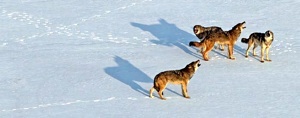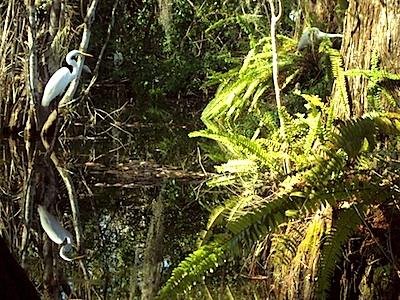When Aldo Starker Leopold in 1953 published his report on how the National Park Service should manage wildlife resources, he wrote that, "(A) national park should be a vignette of primitive America."
While perhaps a laudable goal when Leopold wrote that, that vision seems to drift further away from possibility as society evolves and national parks become hemmed in by development. Roads crisscross many parks, cell towers are sprouting, national parks are becoming biological islands that need more intensive management of their species and landscapes.
Though it did not fully endorse Leopold's vision, the distinguished panel that wrote Revisiting Leopold: Resource Stewardship in the National Parks did call on the National Park Service to tread more carefully with its management decisions when they could impact the natural, and even cultural, worlds within the national parks.
"Because ecological and cultural systems are complex, continuously changing and not fully understood, NPS managers and decision makers will need to embrace more fully the precautionary principle as an operating guide," reads the report, which National Park Service Director Jon Jarvis requested to see how the agency might continue to evolve its resource management as it nears its second century.
"Its standard is conservative in allowing actions and activities that may heighten impairment of park resources and consistent in avoiding actions and activities that may irreversibly impact park resources and systems. The precautionary principle requires that stewardship decisions reflect science-informed prudence and restraint. This principle should be integrated into NPS decision making at all levels."
Loosely defined, the precautionary principle might be seen as, "first, do no harm," a phrase borrowed from the medical community. But how easily can that be accomplished and managed?

Recreational snowmobiling in Yellowstone National Park is one activity that perhaps would not be considered "prudent" under the precautionary principle. Kurt Repanshek photo.
Across the National Park System, there are several high-profile approaches to managing resources that have drawn criticism and which possibly could run afoul of the Revisiting Leopold report's dictate due to their impacts on park resources.
At Big Cypress National Preserve in Florida, the agency is being sued for decisions concerning off-road vehicle access in landscapes considered to be key to more than a few plant and animal species listed as threatened or endangered. Foremost in this leafy and swampy wild kingdom is the Florida panther, which has been described as the most-endangered mammal in North America.
Back in July, a federal court ruled the Park Service acted without sound reasoning in 2007 when it reopened more than 22 miles of off-road vehicle trails in the preserve and ordered that the routes be closed.
Courts currently are reviewing the decision by preserve Superintendent Pedro Ramos to open much of the Addition Lands unit of Big Cypress to ORV use. The Addition Lands had been closed to both ORV use and ORV-assisted hunting ever since they came to the preserve in 1996 while officials worked on developing a management plan for the area. Of the thousands of species of flora and fauna found in the Addition Lands, nearly 100 plants are listed by the State of Florida as endangered or threatened while 29 animal species have federally protected status.
At Yellowstone National Park, the issue of recreational snowmobile access has been flogged for better than a decade at a cost of millions of dollars. While science has pushed the issue towards a resolution that inflicts the park's resources with far fewer impacts than were seen a decade ago, there remain issues relating to bombing mountainsides within the park in the name of snowmobile safety along with the sheer numbers of over-snow vehicles proposed to be allowed into the park on any given winter day.
Point Reyes National Seashore has been the focal point of a bitter battle over the future of a commercial oyster farming operation in an area of Drakes Estero being eyed for officials wilderness designation, a designation that normally would prohibit such things as oyster farms. More than a little science, and more than a little debate over the soundness of that science, has been conducted on the oyster farm's impact on the estero, and a decision on the fate of the Drakes Bay Oyster Co. is due any day now.

Much thought and consideration is being given to the plight of wolves on Isle Royale National Park. Photo courtesy of Wolves and Moose of Isle Royale Project.
Just as easy to cite are instances where the Park Service is being cautious in its approach to managing resources.
At Isle Royale National Park in Michigan, much thought is being put into how, or whether, the agency should intervene to prevent the park's nine wolves from blinking out.
A great deal of thought, science, and consideration was put into the decision -- albeit, a highly controversial one -- at Cape Hatteras National Seashore into how best to manage the needs of piping plovers and sea turtles alongside those of off-road vehicle use on the beaches.
At Olympic National Park, the Elwha watershed is being restored to its natural condition. Two dams have been removed, and crews have been revegetating exposed sediments of the former Lake Mills and Lake Aldwell. The results so far have been impressive, with King salmon migrating back up the Elwha River into the park this summer for the first time in decades.
However, the Park Service is being sued over its plans to release hatchery raised smolts to bolster the Elwha recovery. In its story about that development, the Peninsula Daily News reported that the request for an injunction against the release argued that, “The large-scale releases of hatchery fish proposed to occur this spring will have severely deleterious effects on the wild fish population and their recovery potential."
Obviously, fully embracing the precautionary principle system wide won't be an easy task.
Gary Machlis, the science advisor to Director Jarvis, declined during a recent conversation to discuss the principle specific to Park Service decisions in places such as Big Cypress or Point Reyes. But as a general approach to management in the parks, he was optimistic it could be applied.
“I would tell you that the precautionary principles described by this committee, (the committee argues) that that precautionary principle is necessary as a guiding principle at all levels of the Park Service, not just in Washington, D.C., but at the individual park level," said Dr. Machlis.

King salmon returned to the Elwha watershed in Olympic National Park in August. Photo by John McMillan, NOAA-Northwest Fisheries Science Center.
"And so I would think that if this report has traction, and if these recommendations are accepted, you would see the precautionary principle as a key focus all the way down the line in the Park Service," he continued.
The science advisor did acknowledge that there are times when adopting the precautionary principle into Park Service decisions will be opposed.
"A principle is always a guide in a democracy. There are always competing elements. And as the report clearly states, one of the key things that I think is an advance is the clarity of what this committee wrote about how the Park Service should make decisions," Dr. Machlis said. "And that was a combination of best available, sound sicence, accurate fidelity to the law, and long-term public interest. Not just one of those things, but all three of those things. And I believe that if the Park Service listens to this committee’s recommendations, it will have a very sound basis to make decisions."


 Support Essential Coverage of Essential Places
Support Essential Coverage of Essential Places







Comments
Such a great follow-up piece. Just forwarded it to a couple of friends, a biologist and an historian, whose interests intersect at Leopold.
Sounds like one more reason not to do anything. Maybe we should close all parks to let the flora and fauna go back to their "natural" state.
Zeb, you have solved all our problems. I agree that we should just close the parks and keep the "non-natural" creatures (ie humans) out. After all, the "natural state" of these places was what caused us to set them aside to begin with. Just think, no more blocked traffic because a bison decides to sit down on a road in Yellowstone: there will be no road. The bison can once again roam free, even free from the eyes of man. No cameras, no spotting scopes, no auto exhaust.
Well, the more I think about it the more I disagree. Maybe we can find a way in which we can keep the "natural state" as much as possible and still provide a way for us humans to go to the parks and marvel in those places we love so much because of their natural beauty. I think we can do that without having to allow activities for activities sake.
If you want to have activities for activities sake, go to BLM. They have some nice sites that are managed for just this type of use. Our parks, however, were not. We need to keep to that original "preservationist" concept that drove us to make the first and best national park system in the world.
Gee Dave, I didn't realize us humans weren't "natural".
Our human activities are not. Unless one wants to count things like pollution and New York City as "natural."
But then again, some critters foul their nests almost as badly as we do. On the other hand even those don't have the immense power of machinery and other nest -fouling methods we have at our disposal. We've managed to foul an entire planet. Can any mouse claim to be that good at it?
Out here in Utah, there's a strong belief that God will someday destroy the Earth and us with it. I figure He can save a lot of work by just sitting back and letting us finish the job for Him.
Lee - I think we have found the core of our differences.
You mean you enjoy a foul nest and I don't? Okay. Got it. To each his own . . . .
Cute Lee, but in your typical efforts to make dismissive statements you totally miss the real issue.
I believe in the goodness of man and that man is part of the natural process. You obviously would prefer that man be eliminated from the universe so that your nature can take its course.